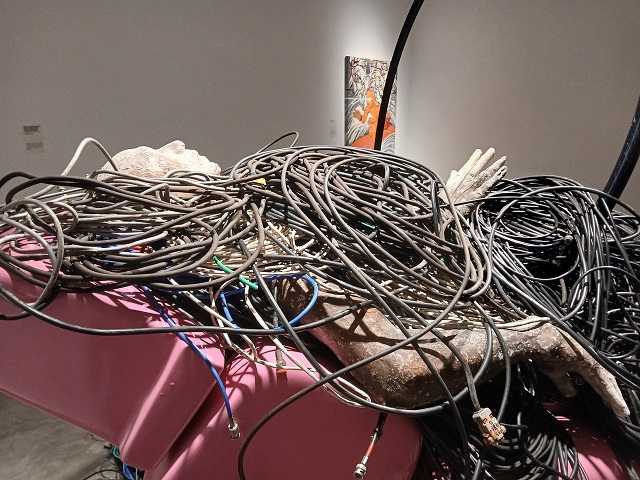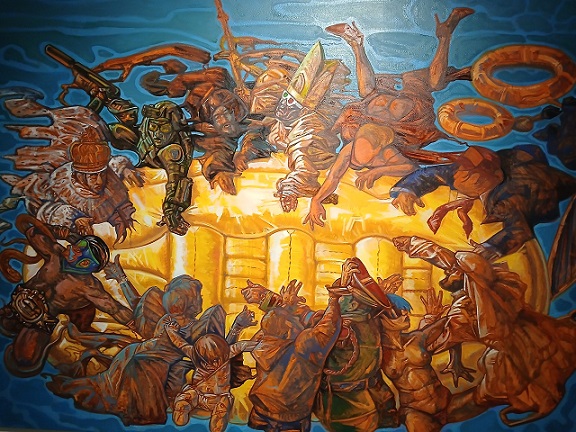In Jose Tence Ruiz’s latest solo exhibition titled The Carbon Footprint of the Stoic Heroic, nine new works are on display —an artist’s searing response in a time of the intentional eradication of Palestine and its people; the crisis of migration; the repressive power of the Church and the State; and the complicity of the powers-that-be everywhere, all at once.
The Carbon Footprint exhibit runs until Nov. 16 at Silverlens Galleries, Makati.

Provoke and ruminate
What is the purpose of your life? Bogie Ruiz hurls an existential question, in his artist walkthrough. In essence, he defines his artmaking as an intentional underscoring, a deliberate marking of the difficulties of being alive, as shaped by specific events and histories of our time.
Being alive means going through the passage of life marked with challenges from cradle to grave. Full of empathy, his works underscore the challenges that all of us go through, describing ordinary Filipinos as bearers of a Sisyphean burden, laborious and almost futile. And yet, we do it all over again the next day and the next, moving forward.
Grit and perseverance

Religious imagery pervades the exhibit, centered on a large installation that occupies the main gallery, titled Ang Pila ng Balde ni Ning, Charie, Charo, Rochit, Rose, Sari, Rosie, Saring, Chayong, atbp. (2024), an ornate baptismal font surrounded by over 400 empty plastic containers in grey and white in a queue, arranged like a rosary.
Queueing is a way of life in the country, especially for Juan and Juana who do not have any connection whatsoever to jump the queue or get ahead in life.

The title painting Carbon Footprint of the Stoic Heroic (2024) depicts a Catholic penitent burned alive on top of a wood pyre, painted white, red, blue, and yellow and thick black lines, a nod to Piet Mondrian’s minimalist lines and colors.
It is a reflection on martyrs, and “what each one leaves behind.” The artist presents a different the notion of “carbon footprint” as one that “questions the value of human life” amidst our tendency to become numb to horrific media images of killings and dead bodies.
Mondrian in dystopia
A longtime admirer of Mondrian (1872-1944), Tence Ruiz appropriates the Dutch artist’s signature visual language “to symbolize the artist’s own “disillusionment and the death of utopia.”
Two paintings, Mondrian’s Denouement:The Hills of Dermis and Mondrian’s Denouement: The Vestida of Carcasses, represent the continuing destruction and carnage in Gaza by Israel, in the name of peace and security. The latter is an iteration of Tence Ruiz’s Kotillon series that depicts a human torso punctured by Mondrian’s lines of squares and rectangles.

In another work, Morion, Miron, Moron, Meron (2024), Tence Ruiz tells us to look closely at the Morion masks of penitents with their three-inch long eyelashes and heavily rouged faces in full makeup glory in Moriones, an annual religious festival in Marinduque. With such gay-looking characters, he offers a critique of the conservative forces in Philippine society with their hypocritical holier-than-thou stance on the LGBTQIA+ community.
The work references the case of Amadeus Pagente as Pura Luka Vega, a drag performer, arrested and sent to jail after courting the ire of the Catholic Church and religious groups. Blasphemous, they said of his drag performance.
Amidst Church scandals across the world involving pedophile priests and their cover-ups, what about Filipino priests accused of sexual abuse? Silence.

My Heart Will GUO On (2024): Making a travesty of national sovereignty, a Pandora’s box has been exposed in the merry-go-round tales of POGOS (Philippine Offshore Gaming Operators) and its insidious effects on Philippine society. Abetted by complicit local officials, the lowest levels of officialdom remain the weakest link in the rule of law.
In the name of greed, greed, and more greed, the painting depicts a perverse Last Supper with power players who prey on the weak and the desperate: a Pope, a heavily armed guy, a king, a geek, refugees, and drowning migrants. Alice Guo will not be the last Chinese with spurious Philippine identity papers.

Jose Tence Ruiz (b. 1956): A multimedia artist, he has a BFA in painting from the University of Santo Tomas. He has done editorial illustrations for publications such as Adarna Books, Manila Times, Manila Chronicle, Philippine Panorama as well as the Singapore Straits Time, 1988-1995, and InterPressService Asia.
His awards include the Thirteen Artists Award, Cultural Center of the Philippines, 1988; Araw ng Maynila Award for New Media, 2023, a five-time Art Association of the Philippines (AAP) award winner, 1979-2000; and the first Filipino to win (honorable mention) in the Biennial of Illustrations Bratislava, Czechoslovakia in 1983.
A highlight of his 50-year career, Tence Ruiz participated as the main artist at the 2015 Venice Biennale after the country’s 51 years of absence from this international art event. As a symbol of Philippine defiance against China’s continuing aggression, he presented Shoal, a huge installation of a decrepit ship shrouded in deep red velvet, representing the BRP Sierra Madre deliberately grounded in Ayungin Shoal, West Philippine Sea.



